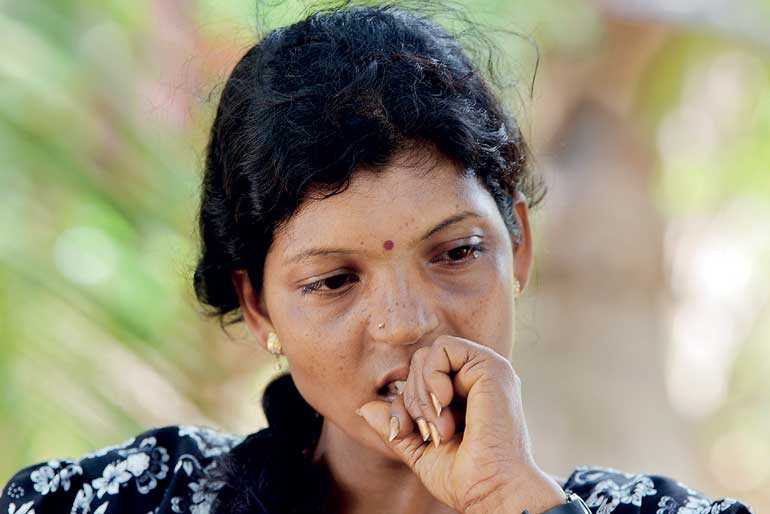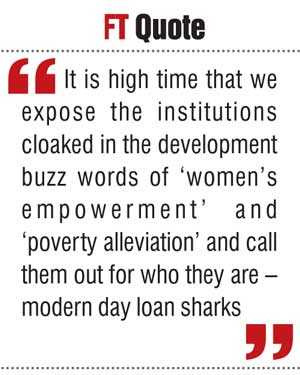Thursday Apr 03, 2025
Thursday Apr 03, 2025
Thursday, 23 August 2018 00:00 - - {{hitsCtrl.values.hits}}
 As women were deemed to be thrifty, able to manage with meagre resources and responsible borrowers, they became the targets for such predatory lending – Pic by Shehan Gunasekara
As women were deemed to be thrifty, able to manage with meagre resources and responsible borrowers, they became the targets for such predatory lending – Pic by Shehan Gunasekara
We are witnessing large protests across the war-torn regions in the north and east, urging the Government to restrict the activities of microfinance companies offering loans to poor women at exorbitantly high interest rates. Women’s groups in other parts of the country are also voicing their concerns.
The Government responded to these protests with an announcement that it will write-off the microfinance loans of 75,000 women in 12 drought-affected districts, who have defaulted payments for three months amounting to Rs. 100,000 or below. An interest rate-cap of 35% will also be imposed on future microfinance loans. While this is a welcome move, it only addresses a fraction of women who have been targeted by microfinance companies.
The microfinance mantra
Heavily promoted in the global south since the 1980s, microfinance seemed to offer the simplest formula for poverty alleviation – a small loan for generating self-employment, which could range from raising chickens to running a small village boutique. These initiatives were expected to generate incomes large enough to bring the poor out of poverty. This narrow vision of development has made microfinance synonymous with ‘poverty alleviation’.
As women were deemed to be thrifty – able to manage with meagre resources and responsible borrowers – they became the targets for such predatory lending. The pretext was of ‘empowering’ women through self-employment.
At the outset the model itself seems to demand unrealistic payback periods and interest rates. As one woman explained, “It takes months for chickens to finally lay eggs and for incomes to be generated. But they expect us to pay-off the debt from the first week. Where will we find the money to feed the chickens and ourselves until then?” Thus, many women end up borrowing again to pay-off the initial loan.
Even in the unlikely scenario that a woman with excellent entrepreneurial skills makes 100% profits on selling eggs, it is impossible for her to make enough to pay interests charged by microfinance companies, which range anywhere between 40% to 220%. How can anyone justify such high interest rates when market interest rates remain at 14% and even credit card interest rate at 28%?
Indeed it is the high interest rates that have attracted non-banking finance companies to join the fray in ‘helping’ poor women. The exorbitant profits recorded in their books and the rapid expansion of Sri Lankan microfinance companies to Bangladesh, Myanmar, Cambodia and Vietnam are testament to who has truly benefited off microfinance! Yet, some economists continue to justify the high interest rates pointing to the risks of lending to poor people in the absence of collateral.
For a long time poor people were excluded from access to banks as they were not considered ‘credit worthy’. The microfinance propagandists claim it extends lending to poor women. In reality, the borrowers are grouped together and held accountable for the loans others have taken. When one woman defaults the other group members are penalised. In other words, the collateral used for microfinance is social pressure, which often leads to tearing apart women’s solidarity.
A strangling noose
The lending practices adopted by microfinance companies have had deep consequences for women, who have built trusted solidarity networks in their villages over years of committed work. However, with the introduction of microfinance, such groups are now co-opted to exploit profits by finance capital. Such extraction destroys the potential for livelihood revitalisation, sustainable savings and local credit initiatives.
Women are resorting to extreme measures to pay back the loans, often skipping meals for children, or selling off their most valuable assets such as gold jewellery, homes and land. Families are estranged when conflicts arise with husbands over loans. Women have been forced to go into hiding to avoid the abuse by collecting agents who refuse to move from the door steps of their homes until payment is settled. Everything they earn is dished out to finance companies as loan payments. And the burden of debt stifles women leaders from participating actively in social organisations. The expansion of microfinance has had a debilitating impact on collective village life. Local community centres and religious spaces are often converted into make-shift offices out of which companies function. Unabated by the sufferings of thousands of women who are mired in debt, the promotion of microfinance loans continue. These are always accompanied by smiling images and selective stories of successful women entrepreneurs who have ‘made it big with the help of microfinance’. Reflecting on this point a senior woman banker mentioned, “Not everyone can become entrepreneurs. Many highly accomplished women like us have opted to remain in salaried jobs. But, we are forcing poor women who have very little resources to turn into entrepreneurs overnight.”
Even the blame for the failure of microfinance is shifted to the women themselves. While the idea of individualised self-employment for income generation was promoted as an economic policy, the individual woman is later blamed often citing consumerism, irrational borrowing, mismanagement and other ‘moral’ causes. Some even propose financial literacy and entrepreneurial skills training as solutions to the problem. However, they fail to examine the inherent problems in the microfinance model, the odious practices of microfinance companies or the problematic assumption that all poor women can become entrepreneurs. In blaming the women they are able to salvage themselves from the responsibility of introducing a bad financial product, poor financial regulations and misled policy choices.
Feminist response to predatory loans
While women’s labour is consistently undervalued, rural economies are neglected and social security benefits are curtailed, how can women’s status improve by merely engaging in ‘self-employment’?
For decades poor women have demanded better access to basic services, like nutrition, health and education and for labour rights to be upheld in the plantations, garment factories and for migrant work. Women have repeatedly demanded social security coverage for those working in informal sectors like agriculture and fisheries. Yet, working women’s voices are continuously ignored by policy-makers. Instead, they are offered the ‘noose’ of predatory microfinance loans.
That the simplistic microfinance model uniformly replicated across developing countries was bound to fail should have been quite apparent. Empirical evidence in countries after decades of microfinance lending show that it neither reduces poverty nor strengthens rural women. Microfinance is indeed symptomatic of the poverty of thinking among development specialists, policy-makers and economists whom together were instrumental in promoting it.
Therefore, as Cat’s Eye we call for a serious introspection of the ideologies which have led to the exploitation of women’s labour and driven them to such ends – that is, development through market mechanisms influenced by neoliberalism. We extend our solidary with women’s groups across the country who are calling the bluff on the financial companies, while financially literate ‘experts’ hold their silence. It is high time that we expose the institutions cloaked in the development buzz words of ‘women’s empowerment’ and ‘poverty alleviation’ and call them out for who they are – modern day loan sharks.
We acknowledge the voices of poor women who have stood up against all odds and are leading the resistance, and together we have to work towards reclaiming the collective spaces of solidarity built by women over the years, away from profit seeking financiers.
(The Cat’s Eye column is written by an independent collective of feminists, offering an alternative feminist gaze on current affairs in Sri Lanka and beyond.)
Discover Kapruka, the leading online shopping platform in Sri Lanka, where you can conveniently send Gifts and Flowers to your loved ones for any event including Valentine ’s Day. Explore a wide range of popular Shopping Categories on Kapruka, including Toys, Groceries, Electronics, Birthday Cakes, Fruits, Chocolates, Flower Bouquets, Clothing, Watches, Lingerie, Gift Sets and Jewellery. Also if you’re interested in selling with Kapruka, Partner Central by Kapruka is the best solution to start with. Moreover, through Kapruka Global Shop, you can also enjoy the convenience of purchasing products from renowned platforms like Amazon and eBay and have them delivered to Sri Lanka.
Discover Kapruka, the leading online shopping platform in Sri Lanka, where you can conveniently send Gifts and Flowers to your loved ones for any event including Valentine ’s Day. Explore a wide range of popular Shopping Categories on Kapruka, including Toys, Groceries, Electronics, Birthday Cakes, Fruits, Chocolates, Flower Bouquets, Clothing, Watches, Lingerie, Gift Sets and Jewellery. Also if you’re interested in selling with Kapruka, Partner Central by Kapruka is the best solution to start with. Moreover, through Kapruka Global Shop, you can also enjoy the convenience of purchasing products from renowned platforms like Amazon and eBay and have them delivered to Sri Lanka.